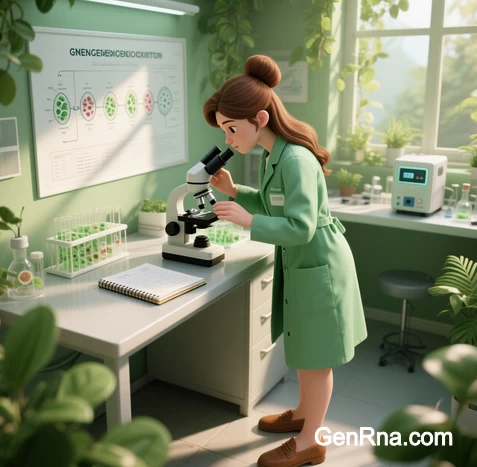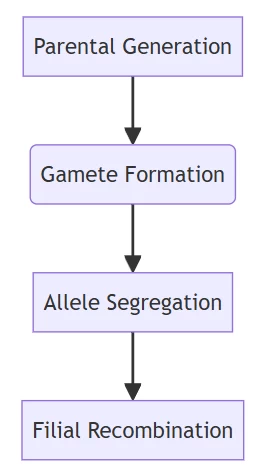 I. Foundational Definitions: Dissecting the Core Concepts
I. Foundational Definitions: Dissecting the Core Concepts
Heredity represents the biological transmission of traits from progenitor to offspring through genetic material. Genetics constitutes the scientific discipline investigating the molecular mechanisms governing this transmission and its variations. This symbiotic relationship forms the cornerstone of biological inheritance, where:
- Heredity manifests as the phenomenon of trait conservation across generations
- Genetics provides the analytical framework decoding hereditary patterns
(Fig. 1: The inheritance continuum)
Description: Schematic representation showing genetic information flow from DNA (double helix) through chromosomes (colored structures) to observable traits (leaf shapes).
II. Historical Emergence: From Observation to Scientific Discipline
A. Pre-Mendelian Understanding
| Era | Conceptualization | Limitations |
|---|---|---|
| Ancient Civilizations | Empirical knowledge of selective breeding | No mechanistic understanding |
| 19th Century | “Blending inheritance” hypothesis | Couldn’t explain trait discontinuities |
B. The Mendelian Revolution (1856-1863)
Gregor Mendel’s pea plant experiments established the quantitative laws governing heredity:
- Law of Segregation:
- Alleles separate during gamete formation
- Law of Independent Assortment:
- Traits inherit independently when genes reside on different chromosomes

This provided the conceptual framework transforming heredity from folk wisdom to predictive science.
III. Molecular Reconciliation: Bridging Phenomenon and Mechanism
A. The Central Dogma Integration
The discovery of DNA’s structure by Watson & Crick (1953) revealed the physical basis of heredity:
- Genes: Functional DNA segments encoding specific proteins
- Chromosomes: Structural units organizing genetic material
- Genome: Complete set of hereditary instructions
(Fig. 2: Molecular choreography of inheritance)
Description: Cryo-EM visualization showing DNA replication (gold strands), transcription (blue RNA polymerase), and translation (ribosome complex).B. Key Distinctions in Modern Context
Parameter Heredity Genetics Nature Biological phenomenon Scientific discipline Focus Trait transmission Gene structure/function Temporal Scope Intergenerational Real-time molecular processes Scale Organismal Molecular to ecosystem levels
IV. Contemporary Framework: Multidimensional Interactions
A. Genetic Architecture of Heredity
- Information Flow:
DNA → RNA → Protein → Trait manifestation - Modulating Factors:
- Epigenetic markers (DNA methylation, histone modification)
- Environmental interactions (diet, toxins, climate)
- Stochastic molecular noise
B. Disciplinary Branches Illuminating Heredity
Subfield Focus Hereditary Insight Classical Genetics Trait transmission patterns Mendelian inheritance laws Molecular Genetics Gene expression mechanisms DNA → phenotype conversion Population Genetics Allele frequency dynamics Evolutionary adaptation Quantitative Genetics Polygenic trait analysis Complex trait heritability
V. Technological Evolution: Reshaping Hereditary Investigation
A. Paradigm-Shifting Innovations
- Genome Sequencing:
- Decodes hereditary blueprint at nucleotide resolution
- CRISPR-Cas Systems:
- Enables precise hereditary material editing
- Single-Cell Omics:
- Reveals mosaicism in cellular heredity
(Fig. 3: Next-generation hereditary analysis)
Description: Automated sequencing platform (left) alongside CRISPR gene editing visualization (right), demonstrating modern genetic intervention capabilities.
VI. Societal Implications: Beyond Biological Realms
A. Transformative Applications
- Precision Medicine:
- Pharmacogenetics tailoring treatments to hereditary profiles
- Agricultural Revolution:
- Marker-assisted selection accelerating crop improvement
- Forensic Science:
- DNA fingerprinting establishing biological relationships
B. Ethical Frontiers
Application Benefit Ethical Challenge Germline editing Eradicating hereditary diseases Unintended generational consequences Genetic privacy Personalized healthcare Discrimination potential Evolutionary intervention Species conservation Ecological balance disruption
Conclusion: The Inextricable Bond
Genetics and heredity maintain a symbiotic relationship where:
- Heredity provides the fundamental biological question
- Genetics furnishes the mechanistic explanation
- Technological innovation continuously redefines their interface
- Societal application demands ethical stewardship
“Genetics is the language decoding heredity’s poetry—a dynamic dialogue between molecular machinery and evolutionary destiny that continually reshapes our understanding of life’s continuity.”
— Nature Reviews GeneticsThe frontier now advances toward predictive hereditary modeling integrating AI with multi-omics data, promising unprecedented intervention in genetic disorders by 2030.
Data sourced from publicly available references. For collaboration or domain acquisition inquiries, contact: chuanchuan810@gmail.com.
- Traits inherit independently when genes reside on different chromosomes
